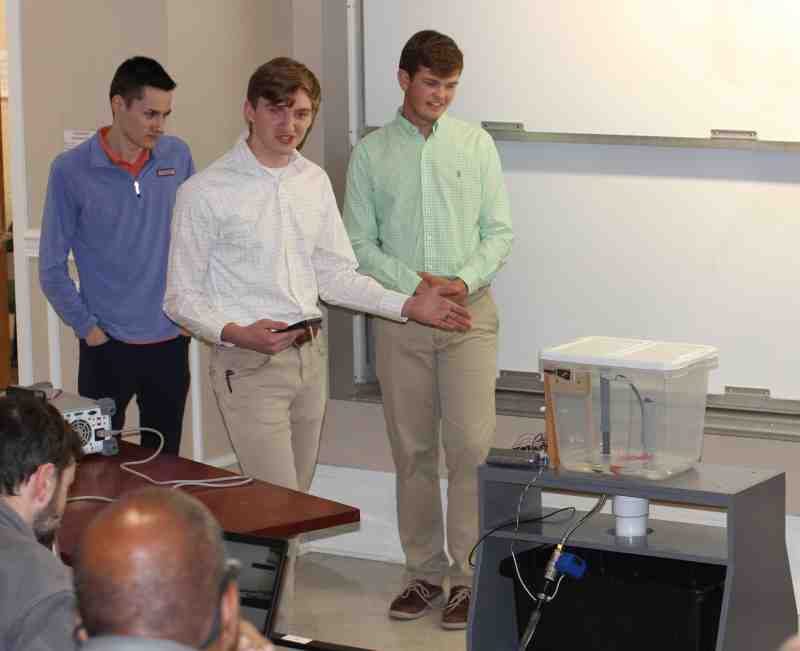MC Electrical Engineering Seniors Showcase Projects That Could Benefit Consumers Nationwide

Senior electrical engineering students at Mississippi College are using their problem-solving skills to develop projects that could help Americans conserve resources, minimize expenses, and even save lives.
The students unveiled prototypes for a drone-based search-and-rescue system that uses radio frequency to locate individuals in post-disaster environment situations when satellite communication is not an option, and an electronic water sensor for lavatories that can detect leaks and control water usage, during a public exhibition in the Math, Chemistry, and Computer Science Building on the Clinton campus.
According to Chris Maggio, associate professor and chair of engineering, computer science, and physics at MC, the projects have the potential to benefit servicepeople and consumers nationwide.
“When students finish the senior design course, they should demonstrate a set of outcomes that are expected of all engineers,” Maggio said. “The entire class is geared toward that assessment, and I thought the presentations were great. I’m proud of the job these students did.
“We always try to come up with projects that have some type of benefit for someone. We felt the drone project hit home for us – it was particularly relevant to what we have experienced in this area of the country. We still remember Hurricane Katrina and the sight of officials going through New Orleans on search-and-rescue missions.”
“Project Drone,” presented by William “Brady” Faessel, Logan Pitts, and Ian Cobb, could save the lives of individuals stuck within their houses following a disaster.
“If somebody was trapped in the attic of their home, point-to-point communication with a satellite isn’t possible through obstructions,” Cobb said. “You have to be outside.
“Our device allows you to transmit a signal that search-and-rescue crews can pick up via a drone payload.”
The project consists of three parts: a beacon that contains the resident’s name, address, and other data; a drone payload that detects and stores the homeowner’s information, and a homing unit that helps locate missing individuals.
“If search-and-rescue crews can’t find the person based upon a GPS tag or an address, they can pull out my component,” said Cobb, who developed the homing unit. “It is a received signal strength indicator. Using a linear LED output, the crew can home in on the beacon’s signal on the ground.”
Cobb said his team felt pressure while working on a device that could one day save lives.
“There were many ethical considerations,” he said. “Throughout the duration of the project, there was a sense that this needs to work and be rigorously tested because this is bigger than a senior design presentation. We couldn’t cut any corners.
“There’s still work that needs to be done, but it’s cool to be a part of something that, in a different revision, could save lives.”
The lavatory water sensor has the capacity to conserve critical natural resources. Maggio said the clever project struck the right balance of what a team of four students could achieve within the two-year time requirement.
“One of the challenges for the faculty when we come up with these projects, is to determine if they will be reasonable given the expectations of the course and the educational background of the students. Are they too easy? Are they too hard? Would the students be done in a week? Would it take a three-year turnaround?
“This project checked all the boxes we needed for a group of four students to complete.”
The “Lavatory Water Level Monitoring and Control System” by Will Buchanan, Luke Blundell, Zack Myers, and Colin Walters replaces the float valve that often performs poorly and can cause leaks when the toilet tank is not filled correctly.
“We replaced the valve with an ultrasonic sensor, an electronic valve, and a microcontroller,” Myers said. “They can all talk to each other, set the water to a specific height, and detect leaks. That can save thousands of gallons of water for a single toilet during a month.
“If apartments were to install this device, they could save up to an estimated $80,000 a year for a 600-unit complex.”
Myers was responsible for developing the application that consumers would use to control the device. After initial installation – in which a calibration routine would help determine the optimum setting for water flow inside the tank – the device would notify the user whenever there was a leak or improper water fill.
To make sure the students are properly progressing from the conceptual stage to a functional prototype, electrical engineering faculty require them to meet a series of deliverables throughout their allotted two-year time frame.
“We usually have a good idea about how long it’s going to take the students to perform tests and report the results,” Maggio said. But we can adjust the deliverable dates if the students need a little more time.
“All of the different milestones the students have to achieve along the way keeps them on track to accomplishing their goals.”
Seeing the projects to completion requires a great deal of trial and error and a considerable amount of patience, but the greatest lesson the students said they learned is the value of teamwork.
“Everybody on my team is vastly different,” Cobb said. “It was challenging working with a team of unique individuals. Learning to communicate with people to solve a problem is important.”
“When people aren’t exactly like you, a lot of times it’s fun, but it can be frustrating,” Myers said. “You have to learn to be open-minded. You’re not always the smartest, and you don’t always have the best solution.
“The teamwork aspect of the project is something you’re always going to deal with as an engineer.”
Maggio said the students present their work four times, including a closed mid-term presentation to faculty in the fall.
“We try to pick apart any flaws they may have in their design and try to stave off any roadblocks for them,” he said. “Not only do they benefit from faculty feedback, but getting to practice their presentations helps prepare them for their final demonstration.”
They present their projects twice more to larger audiences, then give their final demonstrations at the conclusion of the spring semester.
“Getting comfortable talking in front of a crowd, being capable of conveying your ideas to an audience, is a critical skill that engineers have to possess,” Maggio said. “We want to make sure they have plenty of experience doing that.”
Upon completing the public demonstrations of their prototype, the students recognized the value of communication.
“It’s important to be able to explain something technically complex to somebody who may not know what a transmitter or Arduino is,” Cobb said. (For the record, an Arduino microcontroller is open-sourced hardware with varying amounts of flash memory, pins, and features for performing functions such as reading analog signals and performing digital output.) “It is no easy task, but you have to learn how to effectively communicate something important, especially if it could save your life one day.”
“Being able to tell the people you know about what you’ve been working on and spending a lot of time on is imperative,” Myers added.
Effective communication can also make the difference in delivering successful projects.
“You may have the expertise, but if you can’t communicate effectively, you’re not a useful employee,” Cobb said. “If you’re in your own head and you can’t get your thoughts out, you’re not going to be able to contribute. Being able to communicate with someone who may not understand the ins and outs of the project, but communicating what you’re doing and what needs to be done – and understanding that from other people – will set you apart in your future jobs.”
While neither of the projects are close to being “market-ready,” both have the potential for development in the future. Maggio said the electrical engineering faculty have discussed creating “legacy projects” in which one group of graduating seniors hands the reins to the next class to build upon their initial work.
“They could add functionality and further refine the project,” Maggio said. “Or, instead of rolling from one year to the next, we might shelve a project for a few years, then revisit it with another class, have them start over, and see what direction they go in.
“If a project gets far enough along and it is easy to reproduce and meets a lot of specifications, we could tweak it a bit and build upon some of its functionality. We would like to continue to develop these ideas and produce more refined, feature-rich products.”
Regardless of how their senior projects may be developed in the future, the students learned another lesson from their experience – the value of perseverance.
“There were a lot of early mornings that we spent in the lab when we didn’t think our project was going to work,” said Cobb, who will soon be conducting underwater acoustics research for Dynetics Group, a division of Leidos, in Long Beach. “Encouraging each other and learning to work on a team, not just within our subgroups, got us through the semester.
“If we had not done that, neither of the projects would have been successful.”
“If I had quit whenever I thought I wouldn’t be able to complete the project,” added Myers, who has accepted a position with Parry Labs in Huntsville, Alabama, “I would have walked away six or seven times within the last week.”
Sign-up For Our Newsletter
Get the latest news about Mississippi College delivered right to your inbox by subscribing to the Along College Street e-newsletter.


